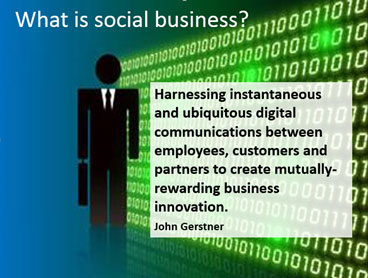
Value flows in multiple directions on an activity stream. For individual employees, this stream of information, concise in text and metadata, allows staying abreast of recent updates and discovering new developments related to their job, projects and areas of interest.
For the organization, the stream exposes the pulse of the organization. It can greatly increase executive awareness of projects, issues, trends and employee ideas and opinions. I know of many cases where an ESN thread has caused a company policy to be changed or rescinded.
It would be nice to say that ESNs are a slam dunk. Unfortunately, the full power of social technologies hinges on the full and enthusiastic participation of employees who are not afraid to share their thoughts and trust that their contributions will be respected. Companies that are deploying ESNs the most successfully are focused on their culture. They understand their shortcomings and are using social tools to solve them.
Creating a collaborative culture is far more challenging than installing the collaborative software. In fact, the technology research company, Gartner, says 80 percent of social business efforts through 2015 will not achieve the intended benefits due to inadequate leadership and an overemphasis on technology.
Trust and recognition are the twin currencies of enterprise social networks. Employees need to be comfortable “working out loud” and sharing rather than hoarding knowledge. “We vs. Me” may be natural for millennials, but may be more problematic for other generations.
Although a 2011 APCO Worldwide and Gagen MacDonald study found 58 percent of employees would rather work at a company that utilizes social media tools, and 60 percent say use of internal social media demonstrates innovation, there are pockets of social resistance from employees at all levels. To get a flavor of that sentiment, here are some verbatim comments from employees at one company that did a pre-ESN project survey:
- “Social is a time suck and really has no value here.”
- “If you have time to be on Yammer you don’t have enough to do.”
- “Social has no place in our Corporate Environment.”
- “We don’t need Facebook at work.”
Of course some employees express the opposite opinion as evangelistically as some of the ESN vendors. When I raised the topic in an employee focus group at a mid-sized company last year, one employee said: “We have a lot of wonderful, even brilliant, people working here. When they start to share their views and discuss topics, you start to see the human side of the organization. The more we discuss and share knowledge, it makes us a better company and better individuals all around.”
Which brings up the first of several hulking elephants in ESN meeting rooms today. Invariably THE QUESTION comes up: how do we get our employees to embrace and use our ESN and not simply ignore or shun it?
Failure to clearly communicating the ESN’s purpose and business case, and get employees on board, can cause a new enterprise social network to drift and die, or simply be seen as a solution in search of a problem.
Even when the technology is intuitive to use and integrated into current enterprise applications, as the best platforms are, if employees don’t see value for themselves and their organization, no amount of marketing and cajoling will get an ESN to thrive.
Over time, employees should rise in visibility in the company by participating in their internal social network. In other words, if I am constantly answering questions and posting ideas, opinions and links to articles and videos on a certain subject, my recognition as an influencer and thought leader should increase. How this will be formally recognized and rewarded are key questions for every organization.
 Some companies are incenting employees to use their networks with gamification techniques, both fun and serious. This allows employees to earn badges and overall scores for their posts, documents uploaded and questions answered. And some companies are now beginning to figure out ways to tie this participation to their annual performance review so there is a financial incentive for being active on the ESN.
Some companies are incenting employees to use their networks with gamification techniques, both fun and serious. This allows employees to earn badges and overall scores for their posts, documents uploaded and questions answered. And some companies are now beginning to figure out ways to tie this participation to their annual performance review so there is a financial incentive for being active on the ESN.
Another scary elephant in the ESN meeting room, hardly ever brought up, is the question: What happens to the traditional command-and-control hierarchy when internal social networking takes hold?
Company executives and middle managers may be among the most skeptical, perhaps because the hierarchy that served them well throughout their careers is part of what has to change to achieve maximum social business success.
“Hierarchies are obsolete,” contends Harold Jarche, international consultant and speaker. “Hierarchies were essentially a solution to a communications problem. They are artifacts of a time when information was scarce and hard to share, and when connections with others were difficult to make. That time is over.”
“Hierarchies prescribe and dictate; networks enable, sense, and generate,” writes Jon Husband on his wirearchy blog. Transforming an organization’s structure, culture and management style is hard. It is also more and more essential in the networked era.”
Ironically, leaders and middle managers who may feel the most threatened by the move toward social are the very ones whose support and participation is critical to an ESN’s success.
“Having strong leaders on board is pivotal to the success of any new way of working,” John Zetterström, CEO at Projectplace, told IT Pro. “Leaders need to become open, social and transparent to promote a new company culture, which will benefit everyone involved. If they don’t adapt, the successful integration of social collaboration strategies will be difficult to accomplish.”
Stowe Boyd, lead analyst at Gigaom Research, believes it’s time that companies appoint a Chief Social Officer. “This should be the executive charged with the well-being, training, recruitment, and connectedness of the company’s workforce,” he writes on his blog. “This role should be made more central to the business, on a par with Sales, Marketing, and Customer areas.”
“It scares leaders,” says David Larcker at the Stanford Graduate School of Business, who asked several hundred executives and board members whether they used social media personally and in their businesses. “It’s hard for them to think through the ramifications and they’ve seen things go viral in a bad way. It’s also hard for them to say for sure that social media adds value or whether this is just another flash in the pan.”
I blame some of the anxiety around enterprise social networks to what I call the Facebook complex. Simply bringing up Facebook in a business meeting can incite sarcastic comments about employees wasting time on cat photos, or using the channel to vent frivolous complaints, or perhaps worse, inadvertently spilling company secrets to outsiders.
For that reason, I used to preface my ESN presentations to senior leaders with the admonition to not think of social media in business as simply Facebook behind the firewall. Both instances use social media technology, but there are stark distinctions between the purposes of the two.
My little advance warning has now become fuzzier, however. Earlier this year Facebook launched Facebook At Work, a workplace clone of its consumer social network. Though currently missing some key features the more established ESN players include in their platforms, it can’t hurt to have almost 1.23 billion monthly users, giving Facebook a clear advantage in employee familiarity with its enterprise tool.
Too much hype, lack of convincing ROI metrics, weak buy-in from senior executives, fear of data insecurity and lack of integration with other enterprise tools are all reasons why deploying social media inside organizations is more like a slog than a sprint. But the mobile, social work place isn’t going away, simply because it offers the best guarantee of organizational survival in the midst of radical business disruption triggered by new technology and innovation.
In that spirit, I invite you to ponder the lowly spider web. Every web begins with a single thread attached to something solid. Then the spider painstakingly weaves a complex structure of spiraling web patterns atop a scaffolding of radiating filaments. Scientists have found cob webs to be so ingeniously designed, resilient and strong that they can survive multiple tears and winds exceeding hurricane strength. Spider webs actually strengthen after they are damaged.
Once its web is weaved, the spider waits. When something strikes any part of a web, the disturbance is instantly felt across every node of the web, and the spider goes into action instantaneously. The web is the spider’s extended central nervous system.
That, metaphorically, is the social business vision that enterprise social networks are weaving. Thread by thread, we’re painstakingly building strong and resilient internal webs that will allow organizations to instantaneously sense and empower employees to act on opportunities, problems and crises.
If the lowly spider web can withstand a hurricane, the future social organization should be able to withstand the radical industry disruptions that are almost certainly already being incubated by some small group of inspired, passionate entrepreneurs out to change the world.
The future digital workplace is coming and in the wry words of Olivia Pope’s mother on the TV hit Scandal: “This is going to be fun.”
- Read Slogging Toward the Social Organization – Part 1. This article originally appeared in the May 2015 Workforce Solutions Review magazine.








1 responses on "Slogging Toward the Social Organization – Part 2"